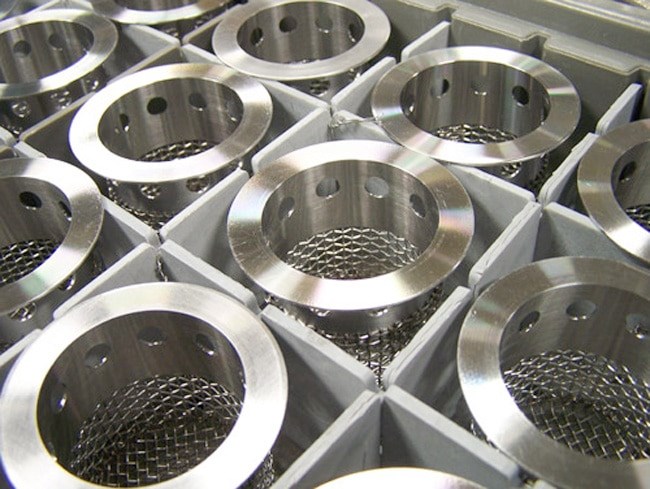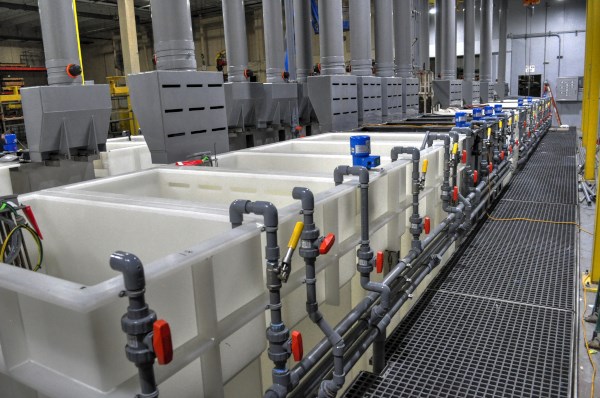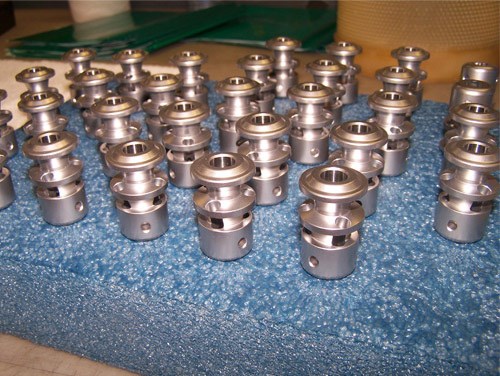How To Passivate Stainless Steel Parts
You've made sure the parts were machined to spec. Now, make sure you've taken steps to protect those parts in the condition your customer expects them.
Share






Passivation remains a critical step in maximizing the essential corrosion resistance of parts and components machined from stainless steels. It can make the difference between satisfactory performance and premature failure. Incorrectly performed, passivation can actually induce corrosion.
What is passivation?
Passivation is a post-fabrication method of maximizing the inherent corrosion resistance of the stainless alloy from which the workpiece was produced. It is not a scale removal treatment, nor is it like a coat of paint.
There is no universal agreement on the precise mechanics of how passivation works. But it is certain that a protective oxide film is present on the surface of passive stainless steel. This invisible film is considered to be extremely thin, less than 0.0000001 inch thick, which is about 1/100,000 the thickness of a human hair!
A clean, freshly machined, polished or pickled stainless steel part automatically acquires this oxide film from exposure to oxygen in the atmosphere. Under ideal conditions, this protective oxide layer completely covers all surfaces of the part.
In actual practice, however, contaminants such as shop dirt or particles of iron from cutting tools may be transferred to the surface of the stainless steel parts during machining. If not removed, these foreign particles can reduce effectiveness of the original protective film.
During the machining process, a microscopic amount of free iron may be worn off the cutting tool and transferred to the surface of the stainless steel workpiece. Under certain conditions, a thin coating of rust may appear on the part. This is actually corrosion of the steel from the tool and not the parent metal. Sometimes the crevice at the embedded particle of steel from the cutting tool or its corrosion products may cause an attack of the part itself.
Similarly, small particles of iron-containing shop dirt may adhere to the part surface. Although the metal may appear shiny in the as-machined condition, the invisible particles of free iron can lead to rusting on the surface after exposure to air.
Exposed sulfides also can be a problem. They come from the addition of sulfur to stainless steels to improve machinability. Sulfides improve the alloy’s ability to form chips that break away cleanly from the cutting tool during the machining process. Unless the part is properly passivated, sulfides can act as initiation sites for corrosion on the surface of the fabricated product.
In both cases, passivation is needed to maximize the natural corrosion resistance of the stainless steel. It can remove surface contamination, such as particles of iron-containing shop dirt and iron particles from cutting tools that can form rust or act as initiation sites for corrosion. Passivation also can remove sulfides exposed on the surface of free-machining stainless alloys.
A two-step procedure can provide the best possible resistance to corrosion: 1. cleaning, a fundamental, but sometimes overlooked procedure and 2. an acid bath, or passivating treatment.

Cleaning First
Cleaning should always come first. Grease, coolant or other shop debris must be thoroughly cleaned from the surface to obtain the best possible corrosion resistance. Machining chips or other shop dirt can be wiped carefully off the part. A commercial degreaser or cleanser may be used to clean off machining oils or coolants. Foreign matter such as thermal oxides may have to be removed by grinding, or by methods such as acid pickling.
Sometimes a machine operator might skip the basic cleaning, assuming erroneously that by simply immersing the grease-laden part in an acid bath, both cleaning and passivating will take place simultaneously. That doesn’t happen. Instead, the contaminating grease reacts with the acid to form gas bubbles. These bubbles collect on the surface of the workpiece and interfere with passivation.
Even worse, contamination of the passivating solution, sometimes with high levels of chlorides, can cause a “flash attack.” Instead of obtaining the desired oxide film with a shiny, clean, corrosion-resisting surface, the flash attack causes a heavily etched or darkened surface—a deterioration of the very surface that passivation is designed to optimize.
Looking for suppliers of Passivation Processes? Start here.
Parts made from martensitic stainless steels [which are magnetic, with moderate corrosion resistance and capable of yield strengths up to about 280 ksi (1930 MPa)] are hardened at a high temperature and then tempered to secure the hardness and mechanical properties desired. Precipitation hardenable alloys (which offer a better combination of strength and corrosion resistance than the martensitic grades) may be solution treated, partially machined, aged at lower temperatures, then finish machined.
In such cases, the parts must be thoroughly cleaned with a degreaser or cleanser to remove any traces of cutting fluid before heat treating. Otherwise, cutting fluid remaining on the parts will cause excessive oxidation. This condition can result in undersized parts with a pitted finish after the scale is removed by acid or abrasive methods. If cutting fluids are allowed to remain on parts that are bright hardened, as in a vacuum furnace or protective atmosphere, surface carburization may occur, leading to a loss of corrosion resistance.
Passivating Baths
After thorough cleaning, the stainless steel part is ready for immersion in a passivating acid bath. Any one of three approaches can be used—nitric acid passivation, nitric acid with sodium dichromate passivation and citric acid passivation. Which approach to use depends on the grade of stainless steel and prescribed acceptance criteria.
More resistant chromium-nickel grades can be passivated in a 20 percent-by-volume nitric acid bath (Figure 1). As indicated in the same table, less resistant stainless grades can be passivated by adding sodium dichromate to the nitric acid bath to make the solution more oxidizing and capable of forming a passive film on the surface of the metals. Another option, used in place of nitric acid plus sodium dichromate, is to increase the concentration of nitric acid to 50 percent-by-volume. The sodium dichromate addition and the higher nitric acid concentration both reduce the chance of undesirable flash attack.
The procedure for passivating free-machining stainless steels (also shown in Figure 1) is somewhat different from that used with the non-free-machining stainless grades. That is because the sulfides of sulfur-containing free-machining grades are partially or totally removed during passivation in a typical nitric acid bath, creating microscopic discontinuities in the surface of the machined part.
Even normally efficient water rinses can leave residual acid trapped in these discontinuities after passivation. This acid can then attack the surface of the part unless it is neutralized or removed.
Free-Machining Stainless Grades
To effectively passivate the free-machining stainless steels, Carpenter has developed the A-A-A (alkaline-acid-alkaline) process that neutralizes trapped acid. This method of passivation can be accomplished in less than 2 hours. Here is the step-by-step procedure:
After degreasing, soak the parts for 30 minutes in a 5 percent solution of sodium hydroxide at 160°F to 180°F (71°C to 82°C). Then rinse the part thoroughly in water. Next, immerse the part for 30 minutes in a 20 percent-by-volume nitric acid solution containing 3 ounces per gallon (22 g/liter) of sodium dichromate at 120°F to 140°F (49°C to 60°C). After removing the part from this bath, flush it with water, then immerse it in the sodium hydroxide solution for another 30 minutes. Rinse the part again with water and dry it, completing the A-A-A method.
Citric acid passivation has become increasingly popular with manufacturers who want to avoid the use of mineral acids or solutions containing sodium dichromate, along with the disposal problems and greater safety concerns associated with their use. Citric acid is considered environmentally friendly in every respect.
Although citric acid passivation offers attractive environmental advantages, shops having success with mineral acid passivation and suffering no safety issues might want to stay the course. There may be no real need to change if those users have a clean shop, well-maintained and clean equipment, coolant free of iron-containing shop dirt, and a process that yields good results.
Passivation treatment in citric acid baths has been found useful for a large number of stainless steel families, including several individual stainless grades, as summarized in Figure 2. The conventional nitric acid passivation methods from Figure 1 are included for convenience. Note that the older nitric acid formulations are in volume percent, while newer citric acid concentrations are in weight percent. It is important to note, in implementing these procedures, that a careful balance of immersion time, bath temperature and concentration is critical to avoid the “flash attack” described earlier.
The passivation treatment varies depending on chrome content and machinability characteristics of the grades in each family. Note the columns referring to Process 1 or Process 2. As shown in Figure 3, Process 1 involves fewer steps than Process 2.
Laboratory tests have indicated that citric acid passivation procedures were more prone to “flash attack” than nitric acid procedures. Factors causing this attack included excessive bath temperature, excessive immersion time and bath contamination. Citric acid products containing corrosion inhibitors and other additives (such as wetting agents) are commercially available products that reportedly reduce sensitivity to “flash attack”.
The ultimate choice of passivation method will depend on the acceptance criteria imposed by your customer. For more information, refer to ASTM A967. It can be accessed at www.astm.org.
Standard Specification for Chemical Passivation Treatments for Stainless Steel Parts

Photo Credit: Imagineering Finishing Technologies
Testing Passivated Parts
Tests are often performed to evaluate the surface of passivated parts. The question to be answered is, “Did passivation remove free iron and optimize the corrosion resistance of the free-machining grades?”
It is important that the test method be matched to the grade under evaluation. A test that is too severe will fail perfectly good material, while one that is too lenient will allow unsatisfactory parts to pass.
The 400 series precipitation-hardening and free-machining stainless steels are best evaluated in a cabinet capable of maintaining 100 percent humidity (samples wet) at 95°F (35°C) for 24 hours. The cross-section is usually the most critical surface, particularly for free-machining grades. One reason for this is that the sulfides, elongated in the direction of working, intersect this surface.
Critical surfaces should be positioned upward, but at 15 to 20 degrees from the vertical to allow any moisture to run off. Material that has been properly passivated will be virtually free of rust, although it may show some light staining.
Austenitic stainless steel grades also may be evaluated by means of a humidity test. When so tested, liquid droplets of water should be present on the surface of samples, revealing free iron by the presence of any rust formation.
A faster method is available using a solution from ASTM A380, “Standard Practice for Cleaning, Descaling and Passivation of Stainless Steel Parts, Equipment and Systems.” This test consists of swabbing the part with a copper sulfate/sulfuric acid solution, maintaining wetness for 6 minutes and observing whether there is any plating of copper. As an alternative, the part may be immersed in the solution for 6 minutes. Copper plating occurs if iron is dissolved. This test should not be applied to surfaces of parts for use in food processing. Also, it should not be used for the martensitic or lower-chromium ferritic steels of the 400 series because false-positive results are likely.
Historically, the 5 percent salt spray test at 95°F (35°C) also has been used to evaluate passivated samples. This test, too severe for some grades, generally is not necessary to confirm that passivation has been effective.
Do's And Don'ts of Passivation
DO clean first, removing all particles of oxide or heat tint before passivating.
DO avoid chlorides that, in excess, can cause a harmful flash attack. When possible, use only a good grade of water containing less than about 50 parts per million (ppm) of chlorides. Tap water is usually adequate, and in some cases up to several hundred ppm chlorides can be tolerated.
DO replace baths on a regular schedule to avoid a loss in passivation potential that can result in flash attack and ruined parts. Baths should be maintained at a proper temperature because out-of-control temperature may allow a localized attack.
DO maintain very specific schedules for solution replacement during high production runs to minimize the possibility of contamination. Use a control sample to test the bath’s effectiveness. If the sample is attacked, it is time to change the bath.
DO assign certain machines to fabricate stainless steels only; stay with the same preferred coolant to cut stainless steels, to the exclusion of all other metals.
DO rack parts individually for treatment to avoid metal-to-metal contact. This is especially important with free-machining stainless steels where free flow of passivating and rinse solutions is needed to diffuse away corrosion products from sulfides and avoid pockets of acid.
DON’T passivate stainless steel parts that have been carburized or nitrided. Parts so treated may have their corrosion resistance lowered to the point where they are subject to attack in the passivating tank.
DON’T use tooling with iron content in a shop environment that is not exceptionally clean. Steel grit can be avoided by using carbide or ceramic tools.
DON’T forget that an attack can occur in a passivating bath if parts are improperly heat treated. High-carbon, high-chromium martensitic grades must be hardened to become corrosion-resistant.
Passivation is frequently performed after a subsequent temper using a temperature that maintains the corrosion resistance.
DON’T overlook the nitric acid concentration in the passivating bath. It should be checked periodically using a simple titration procedure available from Carpenter. DON’T passivate more than one stainless steel at a time. This prevents costly mix-ups and avoids galvanic reactions.
About the authors: Terry A. DeBold is a specialist in Stainless Alloy R & D, and James W. Martin is a specialist in Bar Metallurgy at Carpenter Technology Corp. (Reading, Pennsylvania).
Related Content
Selecting a Thread Mill That Matches Your Needs
Threading tools with the flexibility to thread a broad variety of holes provide the agility many shops need to stay competitive. They may be the only solution for many difficult materials.
Read MoreTips for Designing CNC Programs That Help Operators
The way a G-code program is formatted directly affects the productivity of the CNC people who use them. Design CNC programs that make CNC setup people and operators’ jobs easier.
Read MoreHow to Determine the Currently Active Work Offset Number
Determining the currently active work offset number is practical when the program zero point is changing between workpieces in a production run.
Read More4 Commonly Misapplied CNC Features
Misapplication of these important CNC features will result in wasted time, wasted or duplicated effort and/or wasted material.
Read MoreRead Next
5 Rules of Thumb for Buying CNC Machine Tools
Use these tips to carefully plan your machine tool purchases and to avoid regretting your decision later.
Read MoreBuilding Out a Foundation for Student Machinists
Autodesk and Haas have teamed up to produce an introductory course for students that covers the basics of CAD, CAM and CNC while providing them with a portfolio part.
Read MoreRegistration Now Open for the Precision Machining Technology Show (PMTS) 2025
The precision machining industry’s premier event returns to Cleveland, OH, April 1-3.
Read More























.jpg;maxWidth=300;quality=90)













